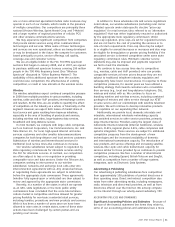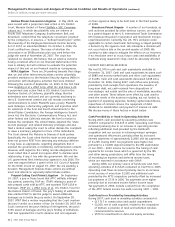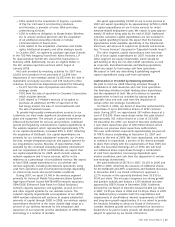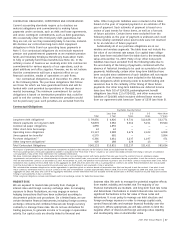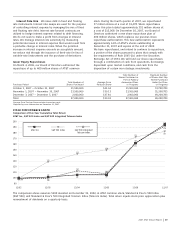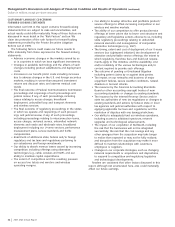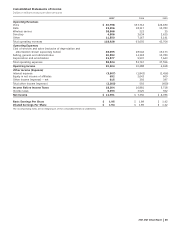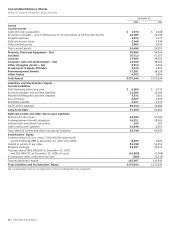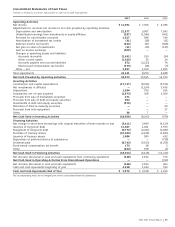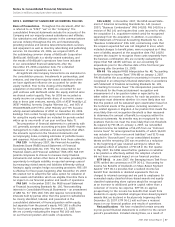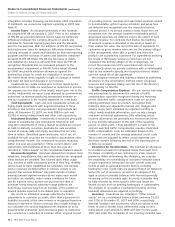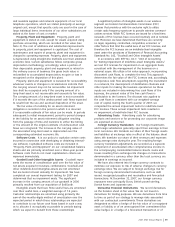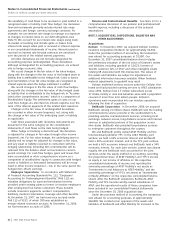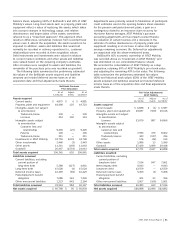AT&T Wireless 2007 Annual Report Download - page 53
Download and view the complete annual report
Please find page 53 of the 2007 AT&T Wireless annual report below. You can navigate through the pages in the report by either clicking on the pages listed below, or by using the keyword search tool below to find specific information within the annual report.
2007 AT&T Annual Report
| 51
Increasing competition in the wireless industry could
adversely affect our operating results.
On average, we have three to four other wireless competi-
tors in each of our service areas and compete for customers
based principally on price, service offerings, call quality,
coverage area and customer service. In addition, we are
likely to experience growing competition from providers
offering services using alternative wireless technologies and
IP-based networks as well as traditional wireline networks.
We expect intense industry competition and market
saturation may cause the wireless industry’s customer
growth rate to moderate in comparison with historical growth
rates. We expect that the availability of additional 700 MHz
spectrum to be licensed through the FCC’s ongoing spectrum
auction could increase competition, the effectiveness of
existing competition, or result in new entrants in the wireless
arena. This competition will continue to put pressure on
pricing and margins as companies compete for potential
customers. Our ability to respond will depend, among other
things, on continued improvement in network quality and
customer service and effective marketing of attractive
products and services, and cost management. These efforts
will involve significant expenses and require strategic
management decisions on, and timely implementation of
equipment choices, marketing plans and financial budgets.
Equipment failures, natural disasters and terrorist attacks
may materially adversely affect our operations.
Major equipment failures or natural disasters, including
severe weather, terrorist acts or other breaches of network
or IT security that affect our wireline and wireless networks,
including telephone switching offices, microwave links,
third-party owned local and long-distance networks on
which we rely, our cell sites or other equipment, could have
a material adverse effect on our operations. While we have
insurance coverage for some of these events, our inability to
operate our wireline or wireless systems, even for a limited
time period, may result in significant expenses, a loss of
customers or impair our ability to attract new customers,
which could have a material adverse effect on our business,
results of operations and financial condition.
The success of our U-verse services initiative will depend
on the timing, extent and cost of deployment; the
development of attractive and profitable service offerings;
the extent to which regulatory, franchise fees and
build-out requirements apply to this initiative; and the
availability and reliability of the various technologies
required to provide such offerings.
The trend in telecommunications technology is to shift
from the traditional circuit- and wire-based technology to
IP-based technology. IP-based technology can transport
voice and data, as well as video, from both wired and wireless
networks. IP-based networks also potentially cost less to
operate than traditional networks. Our competitors, many
of which are newer companies, are deploying this IP-based
technology. In order to continue to offer attractive and
competitively priced services, we are deploying a new
broadband network to offer IP-based voice, data and video
services. Using a new and sophisticated technology on a
very large scale entails risks but also presents opportunities
to expand service offerings to customers. Should deployment
of our network be delayed or costs exceed expected amounts,
our margins would be adversely affected and such effects
could be material. Should regulatory requirements be different
than we anticipated, our deployment could be delayed,
perhaps significantly, or limited to only those geographical
areas where regulation is not burdensome. In addition,
should the delivery of services expected to be deployed on
our network be delayed due to technological or regulatory
constraints, performance of suppliers, or other reasons,
or the cost of providing such services becomes higher than
expected, customers may decide to purchase services from
our competitors, which would adversely affect our revenues
and margins, and such effects could be material.
The impact of our year-end 2006 acquisition of
BellSouth, including the risk that the businesses will
not be integrated successfully; the risk that the cost-
savings and any other synergies from the acquisition
may take longer to realize than expected or may not
be fully realized; and disruption from the acquisition
may make it more difficult to maintain relationships
with customers, employees or suppliers.
We acquired BellSouth in order to streamline the owner-
ship and operations of AT&T Mobility and to combine the
AT&T Mobility, BellSouth and AT&T IP networks into a single
IP network; to speed the deployment, and at lower cost, of
next-generation IP video and other services; to provide
business customers with the benefits of combining AT&T’s
national and international networks and services with
BellSouth’s local exchange and broadband services; and to
create potential cost-savings, technological development
and other benefits. Achieving these results will depend in
part on successfully integrating three large corporations,
which could involve significant management attention and
create uncertainties for employees. To date, this integration
has proceeded on schedule and within our budget
assumptions. We have not experienced any significant
customer or supplier disruptions. However, this process is
lengthy and we expect that it will continue to involve
significant management attention. We also expect to incur
substantial expenses related to the integration of these
companies. We must integrate a large number of systems,
both operational and administrative. These integration
expenses may result in our taking significant charges
against earnings, both cash and noncash, primarily from
the amortization of intangibles. Delays in this process could
have a material adverse effect on our revenues, expenses,
operating results and financial condition. In addition, events
outside of our control, including changes in state and federal
regulation and laws as well as economic trends, also could
adversely affect our ability to realize the expected benefits
from this acquisition.


